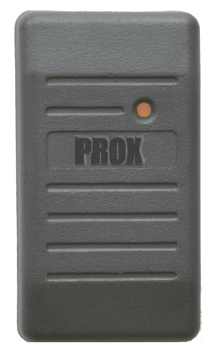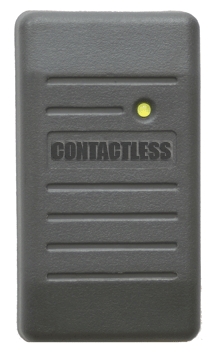
Physical security workhorse begins giving way to contactless as price cuts and multi-technology readers eliminate hurdles
By Chris Corum, Executive Editor, AVISIAN Publishing
You can do more – and you can do it more securely – with contactless than you can with proximity. Few would argue with this statement, yet each year proximity technology continues to outsell contactless in the North American security markets. But new products, attractive pricing, and better market education are turning this tide, making contactless the technology of choice for many professionals charged with securing their physical and logical enterprise.
Contactless technologies use the 13.56 MHz frequency to communicate data between the card and reader while proximity technology uses the lower 125 KHz frequency. Contactless can enable read-write and processing capabilities that become increasingly important as additional applications are desired. Proximity cards are traditionally a read-only technology, where a simple identification number is encoded to the card prior to issuance and that data remains static for life. It is this difference that opens up the possibility for a more robust utilization of the contactless card.
According to Erik Larsen, Product Manager of Identity Solutions for Lenel Systems International, smart card technology enables a host of opportunities. “Post-issuance ID number changes and additions, electronic purse and cashless payment functions, biometric storage and authentication, network access and security, and more,” he explains are all made possible.
The processing capabilities of contactless technologies enable the card to ‘participate’ in the security process, authenticating itself to the reader and protecting its owner’s data until it has verified that the reader is legitimate. “On-board processing also secures key components of biometric identification, cashless transactions, and a wide range of other applications,” adds Mr. Larsen.
 So why does prox still dominate in some markets?
So why does prox still dominate in some markets?
With all these inherent advantages of contactless, why do so many security officers and card system managers still opt for proximity solutions? Until now, there have been a number of legitimate reasons for such a decision, though many suggest this is changing.
Price
There has been the issue of price. “Originally it was cost of cards and readers,” says Mr. Larsen, “but those have been addressed.” In fact, in one well-publicized promotion, HID Corp. began offering its contactless cards and readers for the same end-user pricing as its prox offering. According to HID’s product manager for High Frequency Products, Jack Bubany, “the cost for contactless smart cards and readers is comparable with prox and we are working hard to get this word out to the North American market.”
Infrastructure
So if the technology is superior and the price is comparable, what else could be the holdup? As is often the case with new technologies, legacy infrastructure has been a major deterrent for many buyers. The cost and disruption involved with changing out card readers throughout a facility and re-badging the cardholder population has delayed or dismissed many potential migrations during recent years. Says Mr. Larsen, “customers that have a current system in place want to know what is the cost for reissuance and when will the ROI make sense.”
With prior generation equipment, the answer to this question was often met with dismay. But multi-technology readers capable of communicating with both contactless and prox technology are changing the landscape.
Many of the leading security companies are now offering a multi-technology reader. It can significantly ease a transition from prox to contactless by eliminating the need for a mass re-badging effort. New employee cards, replacement cards, and those with need for added security or functionality can be issued the contactless card beginning day one, while other cards are phased in over time or simply allowed to churn via the normal cycle of employee and card turnover.
 “Even if a company has not made a conscious decision toward a particular contactless smart technology it’s only a matter of time before someone from the IT department asks the security group about their smart card plan,” says Jon Menzel, President and CEO of reader manufacturer XceedID. “If a company has been purchasing Multi-tech readers over time (and used them as simple prox readers) then they will have already invested a substantial amount toward the smart card upgrade without allocating special funds to do so. This greatly reduces the follow on investment to move all cards and readers to contactless technology.”
“Even if a company has not made a conscious decision toward a particular contactless smart technology it’s only a matter of time before someone from the IT department asks the security group about their smart card plan,” says Jon Menzel, President and CEO of reader manufacturer XceedID. “If a company has been purchasing Multi-tech readers over time (and used them as simple prox readers) then they will have already invested a substantial amount toward the smart card upgrade without allocating special funds to do so. This greatly reduces the follow on investment to move all cards and readers to contactless technology.”
But these multi-technology readers are proving to have an important role beyond just a transition-enabler. “Your entire population may not need to go (contactless) smart cards,” explains Mr. Larsen, “or they may not need to go on a first phase deployment. Look at a multi-technology reader for the common areas where both populations need access and then use the 13.56 only at the secure doors.”
“Many large companies are content with their current card populations but have disparate technologies in multiple locations (i.e. HID prox in New York, GE/Casi prox in Los Angeles, and Mifare in London),” explains Mr. Menzel. “… Multi-technology readers function with all of these cards simultaneously saving significant investment dollars required to transition to one card.”
In the past, HID helped clients address the migration from prox to contactless with cards that combined the two technologies, but a new reader provides another alternative. Says Mr. Bubany, “some may see the card as the best migration point and some may see the reader. It depends on the client’s specific environment and needs.”
Education
With the obstacles of price and infrastructure seemingly all but eliminated, what else could delay the move to contactless technology? According to Mr. Larsen, the final hurdle is market education. It seems that while the vendor community has made the transition relatively painless, the buzz has not yet caught up. Say Mr. Larsen, “the general population is thinking it is still too expensive.” Additionally there remains a distinct level of confusion as to the capabilities of contactless technology.
But the end user is not the only community in need of education. “The security reseller and integrator segments need thorough education to ensure they can best help their customers,” adds Mr. Larsen.
Any salesperson will tell you that it is generally easier to sell something you have sold before and know well. This existing comfort level with proximity technology is perhaps the last major hurdle to increased market presence for 13.56 MHz. “The key customer-facing component of this industry is the integrator layer,” says Mr. Menzel, “and they must buy-in to both the benefits of contactless technology and see a reward for selling it over other solutions.”
“At HID we conduct workshops in major cities,” says Mr. Bubany, “one for dealers and one for end users to help them understand what smart card technology offers them. The goal is to give them a level of comfort so that they can feel safe selling the newer technology to clients or implementing it in their organization.”
Next steps
Many suppliers of security components are actively working with resellers and integrators to educate them of the new environment surrounding contactless. As these programs disseminate the information on improved technology, comparable pricing, and stronger security, it seems likely that North America will trend toward contactless technologies … joining the rest of the world’s security markets.
In the next installment of our physical security corner, we will continue this examination of contactless and proximity technologies. Part two of this article focuses on issuance, contrasting the challenges and opportunities that the divergent technologies present to the issuing organization.




